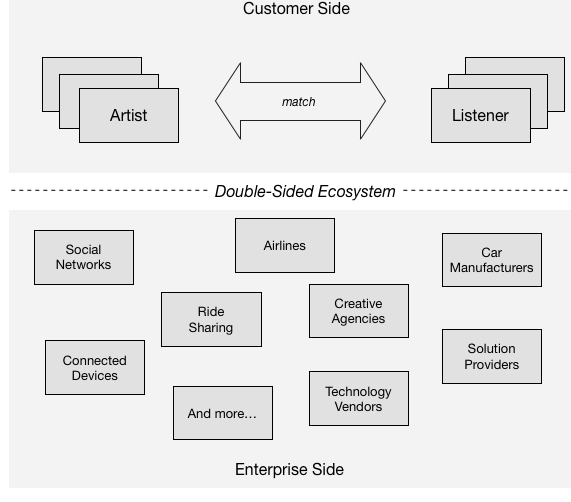Platform businesses really understand what producers and consumers participate in their ecosystem. But what if I was to tell you that there are two sides to the ecosystem. That’s right, a double-sided ecosystem. Right now, you should be asking yourself, am I catering for both sides? Let’s see.
When we talk about ecosystems, the discussion tend to focus on the customer side. We talk about producers and consumers and the customer journeys they take to co-create value. But stop and think. Who crafts these customer journeys? Who is responsible for ensuring producers and consumers play nicely? How do we continuously add/modify/remove customer journeys? How do we onboard and/or remove producers and consumers? Well, that’s the flip side of our double-sided ecosystem; the enterprise side. Let’s bring this together with an example.
The Spotify Double-Sided Ecosystem
Why does Spotify exist? It’s mission is to:
Give people access to all the music they want all the time – in a completely legal and accessible way.
Spotify has over 70 million paying subscribers. That’s nearly 3 times more than it had a couple years ago. Growth is great at Spotify. Business is booming, but how is Spotify doing this? A large part of it is having a well-understood double-sided ecosystem. Take a look.
Spotify has a deep understanding of its artists (producers) and listeners (consumers) on the customer side. Everything Spotify does goes back to making music accessible to listeners. In order to deliver on that mission promise on the customer side, Spotify manages a complex network of agencies, partners and vendors on the enterprise side. It doesn’t matter that every enterprise participant has their own goals. So they have their own reasons for being part of the Spotify ecosystem. That’s healthy. However, Spotify’s clear mission statement is an essential north star and organising principle for all participants within the ecosystem.
Virgin America partners with Spotify on the enterprise side, in-line with it’s mission statement below, to give its flyers a better experience when they travel. What better way to do that than to give flyers access to the music they love whilst traveling.
Embrace the human spirit and let it fly – Virgin America’s mission statement
For Spotify, Virgin America gives them:
- A new user acquisition channel of flyers not on Spotify yet.
- Increases conversation opportunities for Spotify for non-paying users to become paying subscribers.
- Decreases churn rate by actively demonstrating that Spotify is accessible everywhere.
Customer side
The customer side of the double-sided ecosystem is the easiest to explain. That’s because its participants, the producers and consumers, are well-understood and proactively marketed as such by the business. For example, drivers and riders are the producers and consumers respectively within the Uber ecosystem on the customer side. Everything within the Uber mobile app is geared around enabling drivers to get riders from pick up to destination. The app continually learns and delivers the best customer experiences at every interaction a driver has with a rider. All tasks performed by drivers and riders are well thought through. Every touch point in the customer journey, designed for. This is all reflected in the mobile app that encompasses everything on the customer side within Uber’s double-sided ecosystem.
Enterprise Side
The enterprise side is comprised of agencies, partners and vendors to enable the customer side. The enterprise side operationalises the customer customer side. So how does the enterprise side support the customer side? Enterprise participants need to be incentivised to deliver against the ecosystem mission, whilst also meeting their own company goals. Like Spotify, Uber grows and nurtures a network of agencies, partners and vendors on the enterprise side of their double-sided ecosystem. This is a both network and a community, subject to all challenges that accompany the management of independent and entrepreneurial parties. Command and control is not the way to proactively manage participants on the enterprise side. They are good reasons why partner relationship people and processes factor very highly within leading organisations.
Where Next
However, companies are struggling to articulate the customer side and operationalise the enterprise side today. They struggle because it’s hard.
How many times have you heard something along the lines, know your customer. Too many? Well, guess what, you have to really, truly and deeply need to know everything about your producers and consumers on the customer side. Then, you also have to govern a compete and collaborate culture across all participants on the enterprise side. When you do, one side of the double-sided ecosystem starts to inform and is informed by the other. You effectively close the loop. And in doing so, increase the amount of learnings that can be turned into insights, to prioritise relevant ideas to drive real impact across the business.
We saw how our SAUNA companies (e.g. Spotify, AirBnB, Uber, etc.) lead the way in defining and growing thriving double-sided ecosystems. They look to maximise the value exchange between producers and consumers at every interaction on the customer side. Where on the enterprise side, they invest heavily to build lasting relationships with agencies, partners, and vendors. Double-sided ecosystems are not uncommon. However, they are rarely articulated in such a way to expose the problems that need to be solved. It’s worth investing just a little time to double check you’ve got yours in order.


